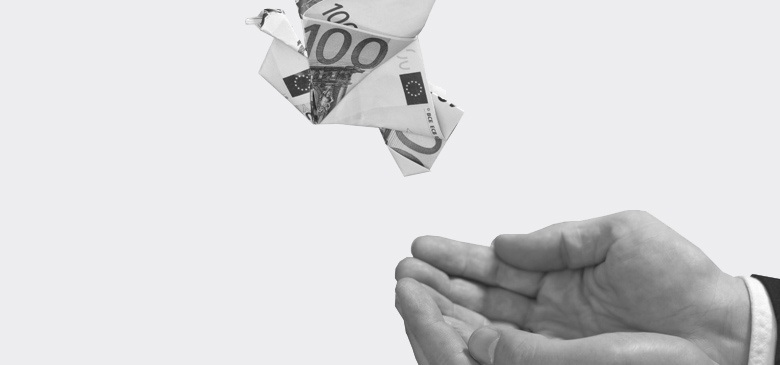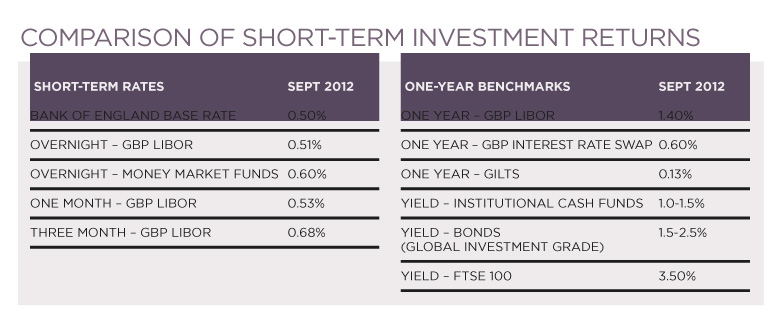
It is not the destination that matters; it is how you get there safely.
In today’s low-interest-rate environment, investing surplus cash to maximise returns is a significant challenge. Research shows that European corporates have accumulated significant cash balances (an estimated £750bn has been hoarded in the UK alone), suggesting that security and protection from the unexpected still take priority.
Opting for higher returns involves greater risk, the assessment of which is no longer straightforward. Recent events in the eurozone demonstrate that risks can appear from the least-expected quarter. As a result, stakeholders need to consciously quantify the acceptable level of risk and types of investment that their business can accommodate.
On the other hand, the opportunity cost of accepting low yields and prioritising security and liquidity also needs to be calculated. There is the value of income being given up to consider, the investments that could be achieved and the chance to make more efficient use of cash. From a shareholder perspective, the aim should be to achieve a balance between risk and return.
The ability to take an independent approach to risk is a vital component of avoiding herd-like trends when making investment decisions. Remember the Icelandic banking collapse in 2008? It caught out many private and public-sector organisations that were chasing higher, ultimately unsustainable, yields – albeit from deposit-taking banks approved by UK regulators.
While there are no guarantees, if you carefully select counterparty limits and balances, you should still be able to diversify risk and seek enhanced returns. Investing in higher-risk countries such as Greece or Spain does not require a lengthy debate, just common sense and a regular review process. Similarly, placing deposits with counterparties that have a high exposure to the euro – if known – may not be deemed appropriate.
The ability to match cash requirements to liquidity, and thus the maturity of investments, is an integral part of creating a portfolio. The quest for higher yields often leads to a longer maturity profile that requires cash to be classified into operational short-term cash and surplus long-term cash.
Given all the factors involved in accurately forecasting cash, the ability to define the surplus cash available for longer-term investment will be important in achieving higher yields. The assessment of true liquidity (when a financial shock occurs) is very subjective and is best approached through assessing the counterparty and underlying investments.
At the time of writing, yields on overnight deposits are in the order of 0.5%, with money market rates at 0.6%. Money market funds (MMFs) are widely used, but offer only marginally better cash returns and may well have hidden counterparty risks.
The treasurer has a number of investment choices to assess for better returns:
Corporate bonds can be used to achieve higher returns in the order of 1.5-2.5%. The key here is assessing individual risk and corporates need to have the resources to be able to assess and monitor individual bonds. Multinationals with strong track records may offer a better alternative to the banks and have less exposure to the euro. The downside is that when interest rates start to move upwards (which will happen eventually), a sharp sell-off in bonds cannot be ruled out.
There are alternative methods of generating higher yields without using specific treasury instruments. These are indirect methods that achieve the same result:
Investment rates on cash will vary with the market and counterparty circumstances. The ability to use treasury management systems to report and review holdings and returns is key. This enables monitoring of risk and highlights when yields are falling or trends are developing. Greater transparency and online reporting enables treasurers to change or amend investments and react quickly to adverse movements.
Investing in higher-risk countries such as Greece or Spain does not require a lengthy debate, just common sense and a regular review process
The solution to risk is knowledge and corporates are realising they need to evaluate the use of cash in more detail and update their cash investment policies. An assessment has to be made as to the purpose of holding cash, and then match that to an objective in terms of both return and risk. The trend in Europe for investing cash is conservative at present and corporates should, in our view, be actively working to achieve greater returns on their growing cash balances.
While balance sheet strength is clearly important, so is the threat of inflation, and with the current low-interest-rate environment, the value of cash is being eroded every day. Treasurers should not be afraid to cross the bridge and seek higher yields.

Dominic Jaques FCT is managing director of treasury, risk and cash management consultancy Tresauris.
W: www.tresauris.com
